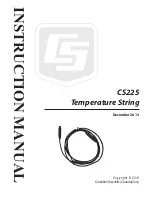
5 96VTR Ver. 2.0 11/99
'MA' Manual Mode Status LED
Illuminates when the controller is in Manual Mode of operation, which permits the user to
drive the control output manually. Refer to Section 10 for more details.
'AT' AUTO TUNE Status Indicator
When the controller is autotuning, this LED will blink. When the meter is finished tuning,
the LED will extinguish. Auto Tuning may take from several minutes to several hours
depending upon the process in question. Refer to Section 9.2 for more on Auto Tune.
'C' or ‘F’
Temperature Units Indicator for degrees C/F
LED Error Messages:
Err 1
: A/D converter is inoperable. Unit must be repaired or replaced.
uuuu
: Input under-range condition or input sensor not connected.
nnnn
: Input over-range condition or input sensor not connected.
OPEN
: Input sensor not connected or is inoperable.
5.4 Keypad Descriptions
SCROLL Key
While programming the controller you can move from one programmable parameter
to the next by pressing the Scroll key. The Scroll key is also used in combination with
the RETURN key to move between programming levels. The red LED display will
show each parameter title as you scroll through the list. Also, to activate an
autotuning session, press and hold this key for 5 seconds.
UP Arrow Key
Increases the Setpoint (SV) and increments parameter data when programming.
DOWN Arrow Key
Decreases the Setpoint (SV) and decrements parameter data when programming.
RETURN
KEY
During normal operation, pressing the RETURN key permits the user to view the
controller's output action as a percentage (0.0 to 100.0% power). The lower (green)
display will indicate 'H' (heating outputs) followed by a percentage. After a few
seconds, the controller will automatically display a 'C' (cooling output). Press the
RETURN key from any mode to return to the normal SV display. The Return key
pressed with the SCROLL key moves from one programming level to the next.
Table I - Programming Level Parameters at a glance
1st Prog. Level
2nd Prog. Level
3rd Prog. Level
4th Prog. Level
rAmp
Pb
rEmo
LoCA
oPoF
CPb
P-L
HiCA
A1SP or timE
ti
A1Fu
tunE
A2SP
td
A2Fu
db
A1HY
A2HY
Act
unit
dp
Ct
C Ct
HYST
EroP
Addr
PVoF
tYPe
LoLt
HiLt
Notes:
Symbols shown above
are similar to the actual meter
LED displays which show
parameters in mixed case. Some
parameters and even the 4
th
programming level can be locked
out depending upon the setting in
P-L (Parameter Lock in 3
rd
programming level).

































